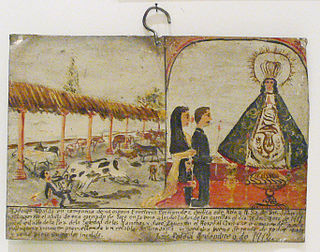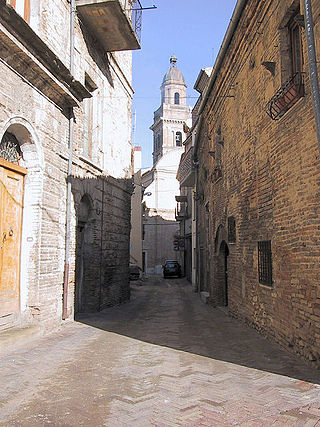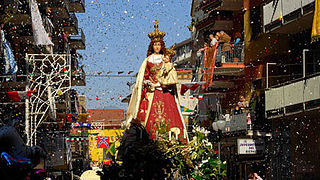
The term Black Madonna or Black Virgin tends to refer to statues or paintings in Western Christendom of the Blessed Virgin Mary and the Infant Jesus, where both figures are depicted with dark skin. Examples of the Black Madonna can be found both in Catholic and Orthodox countries.

An ex-voto is a votive offering to a saint or a divinity, given in fulfillment of a vow or in gratitude or devotion. The term is usually restricted to Christian examples.
A patronal feast or patronal festival is a yearly celebration dedicated – in countries influenced by Christianity – to the 'heavenly advocate' or 'patron' of the location holding the festival, who is a saint or virgin. The day of this celebration is called patronal feast day, patronal day or patron day of said location.

The Solemnity of Mary, the Holy Mother of God is a feast day of the Blessed Virgin Mary under the aspect of her motherhood of Jesus Christ, whom She had circumcised on the eighth day after His birth according to Levitical Law. Christians see Him as the Lord and Son of God.

Pagani is a town and comune in Campania, Italy, administratively part of the Province of Salerno, in the region known as the Agro nocerino-sarnese. Pagani has a population of 35,834, as of 2016.

Quindici is a town and comune of the province of Avellino in the Campania region of southern Italy. Its population is about 3,000 inhabitants.

Casalbordino is a comune (municipality) and coastal town on the Adriatic Sea, within the Province of Chieti of the Abruzzo region of central-eastern Italy.
Our Lady often refers to:

Our Lady of Graces or Saint Mary of Graces is a devotion to the Virgin Mary in the Roman Catholic Church. Several churches with this dedication often owe their foundation to thankfulness for graces received from the Virgin Mary, and are particularly numerous in Italy, India, Australia, United States, Portugal, France and the Italian-speaking region of Switzerland. Also it is related to the Marian apparitions in which was revealed the Miraculous Medal, also known as the Medal of Our Lady of Graces.

The Virgin of Mercy is a subject in Christian art, showing a group of people sheltering for protection under the outspread cloak, or pallium, of the Virgin Mary. It was especially popular in Italy from the 13th to 16th centuries, often as a specialised form of votive portrait; it is also found in other countries and later art, especially Spain and Latin America.

Santuario della Madonna del Divino Amore, or the Shrine of Our Lady of Divine Love, is a Roman Catholic shrine in the southern outskirts of Rome dedicated to the Blessed Virgin Mary that consists of two churches: an old church built in 1745 and a new church added to the sanctuary in 1999. The church was included by Pope John Paul II in the pilgrimage of Seven Pilgrim Churches of Rome during the Holy Year 2000.

Traditions of Italy are sets of traditions, beliefs, values, and customs that belongs within the culture of Italian people. These traditions have influenced life in Italy for centuries, and are still practiced in modern times. Italian traditions are directly connected to Italy's ancestors, which says even more about Italian history.

Our Lady of the Good Event of Parañaque (Spanish: Nuestra Señora del Buen Suceso de Parañaque; Filipino: Ina ng Mabuting Pangyayari ng Parañaque is the name of a statue of the Madonna and Child enshrined in St. Andrew's Cathedral in Parañaque, Philippines. The original Spanish name is often incorrectly rendered in English as Our Lady of Good Success due to the superficial similarity between the Spanish word "suceso" and the English false friend "success."
The Second Sunday of Easter is the day that occurs seven days after the Christian celebration of Easter. Those churches which give special significance to this day recognize it by various names. In the Catholic Church, this day is generally known as Divine Mercy Sunday. Across Western Christianity more broadly, this day is also known as the Octave Day of Easter, White Sunday, QuasimodoSunday, Bright Sunday, and Low Sunday. In Eastern Christianity, this day is known as Antipascha, New Sunday, and Thomas Sunday.

The Sanctuary of Madonna dei Miracoli is a church in Alcamo, province of Trapani, Sicily, southern Italy; it is dedicated to the Madonna of the Miracles.

Our Lady of Miracles is the patron saint of the town of Alcamo.

Mussomeli is a town and comune in the province of Caltanissetta, Sicily, Italy.

Our Lady of the Hens or Madonna of the Hens is a Roman Catholic title of the Blessed Virgin Mary venerated in honour of the Marian apparitions and miracles that are claimed to have occurred between 1609 and 1610 in Pagani, Campania. A large cult devotion has since developed, and a large church was built at the site that has since become a major site of Marian pilgrimage.

The Shrine of Saint Mary the Crowned of Carmel, also called Shrine of Our Lady of the Hens, is a Roman Catholic Marian shrine located in Pagani, Campania, annually hosting the feast of Our Lady of the Hens.

The Santuario della Madonna dell'Arco is a Roman Catholic shrine in Sant'Anastasia, a town at the feet of Mount Somma. It is a pilgrimage destination for the so-called 'fujenti' or 'battenti' pilgrims from all over the Campania region every Easter Monday. As they walk, they usually sing a traditional folk song first written in the 15th century and later put to music. A fire is also lit on the bell tower every second Sunday in September for the feast of the Coronation of the Virgin.
























